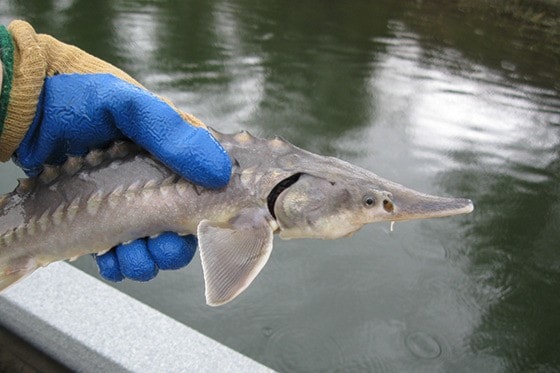Although Vanderhoof has limited leverage in the grinding effort to build a Nechako white sturgeon recovery centre here, council has again emphasized the facility's importance to the critically imperiled prehistoric fish.
Building the recovery centre is not a top priority for the district compared to a new college campus, an aquatic facility, seniors' housing, or a community centre, town council said last month.
But at a meeting on Feb. 25, Mayor Gerry Thiessen reiterated the need to build the facility quickly to prevent the endangered Nechako white sturgeon from declining any further in status and number.
"This is at a do-or-die point for the species," said Thiessen, with frustration in his voice.
For many months, the Freshwater Fisheries Society of B.C. (FFSBC), the Nechako Environmental Enhancement Fund Management Committee (NEEF), Rio Tinto Alcan (RTA) and the provincial government have been negotiating for funding to build the centre.
"They're going to have to get together on this soon or this species isn't going to make it," said Thiessen.
Notable progress has been made in recent weeks, and at least one major compromise has been made by the FFSBC, but if the project doesn't commence within the next month, another year could be lost, said Don Peterson, chair of the private non-profit society.
So far the FFSBC has acquired about $3.5 million to build the recovery centre for the Nechako White Sturgeon Recovery Initiative.
The District of Vanderhoof has offered $310,000, plus two acres of land, a waiver of all building permit fees and a permissive tax exemption, the values of which have not been officially determined, according to Deputy Administrator Tom Clement.
In September 2012, the NEEF management committee decided to set aside $4 million in contributions from RTA for the purposes of operating the recovery centre, but stipulated that the money could only be accessed if matched in kind by another group.
"In this case, we have the other funds," Peterson said on Wednesday, Feb. 27.
"All we are asking is that the (RTA) contribution to NEEF matches what we already have in hand."
Last week, the FFSBC submitted an amended proposal to the NEEF management committee recommending that money for the recovery centre be deposited into an account with the Northern Development Initiative Trust, a non-profit economic development corporation that manages more than $200 million of investment funds for various projects in central and northern B.C.
The average return on Northern Development investments from 2009 to 2012 was 9.2 per cent, said Chief Executive Officer Janine North.
"Part of this money is public money, contributed by the province," said Peterson.
"We want to house it with the trust so it can generate revenue and help ensure that the project is delivered successfully."
The Northern Development trust would help alleviate potential financial risks and costs associated with constructing and operating the recovery centre by generating investment income over time, said Peterson.
"Risk is simply a reality in managing any large project. We have done our homework but have no cushion for unforeseen cost items," he stated in an email on March 1.
With the window closing to build the sturgeon facility in 2013, the FFSBC last month rescinded a resolution requiring a minimum of ten years of operating funds before committing the $3.5 million it had amassed for the project.
This money combined with the district's contribution and matched by RTA would enable the recovery centre to operate for about seven years after construction.
"We will not build the facility unless the financial risk is addressed, and we have indicated the risk will be addressed if we can invest those funds into the trust," said Peterson.
